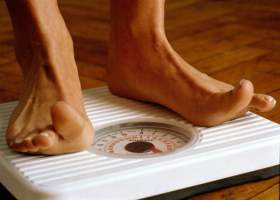September 26, 2012
- Younger students need to sleep for at least ten hours
- The Mediterranean diet is useful for middle-aged women
- Causes of amenorrhea
- Coffee in large quantities to provoke the development of diabetes
 Neyroobmenno-endocrine syndrome It manifested as a result of the impact of infringements of hypothalamic character. In recent years, experts say about the direct influence on the progression of the disease genetic predisposition. In addition, for the manifestation of this disease is characterized by resistance to Insulin . As a consequence, this factor, as well as excess weight can cause serious complications. It hypertension , Insulin- diabetes . atherosclerosis . stroke . heart attack . Often, weight reduction is a prerequisite to a significant improvement, and sometimes - and to recovery.
Neyroobmenno-endocrine syndrome It manifested as a result of the impact of infringements of hypothalamic character. In recent years, experts say about the direct influence on the progression of the disease genetic predisposition. In addition, for the manifestation of this disease is characterized by resistance to Insulin . As a consequence, this factor, as well as excess weight can cause serious complications. It hypertension , Insulin- diabetes . atherosclerosis . stroke . heart attack . Often, weight reduction is a prerequisite to a significant improvement, and sometimes - and to recovery.
Therefore, the presence of women obesity and insulin resistance are often in medicine is defined as a separate metabolic syndrome . This name is also sometimes used in medicine, but it should be noted that the diagnostics and examination of patients in this case not restricted only to reduce body weight. Women who are diagnosed neyroobmenno-endocrine syndrome, it is important to restore the full reproductive function of the body, as well as conduct an effective therapy hyperandrogenism .
Symptoms neyroobmenno-endocrine syndrome
With the development of this disease in humans significantly disrupted hormone function of the adrenal glands and ovaries. The syndrome occurs as a result of certain disorders of the pituitary . hypothalamus . fat tissue . If this syndrome occurs in non-pregnant women, its symptoms are very similar to mild Cushing's disease .
The main symptoms neyroobmenno-endocrine syndrome is a disruption of the menstrual cycle, a very rapid weight gain leading to obesity, thirst , Changes in appetite, frequent headaches, insomnia, regularly occurring respiratory virus infections.
This disease most often develops in women after childbirth. If a young mother suffered a complicated childbirth, or her complications occur in the postpartum period, then we can talk about postpartum neuroendocrine syndrome .
But his symptoms may also occur after trauma, severe stress, infections that affect the nervous system. Sometimes neyroobmenno-endocrine syndrome is also seen after the incident abortion or abortion . Endocrinologist define this diagnosis as a hypothalamic syndrome.
Symptoms of this condition are manifested as changes in the skin: the skin appear extensions - Bands that resemble scars. Initially, the color maroon, striae later acquire a pale pink hue.
In places the folds of the skin of a woman appear spots, slightly rough to the touch. These spots are formed mainly in the armpits, under the breasts, the skin of the abdomen, in the groin. Such changes - the result of the loss of sensitivity to insulin. Because of lack of female hormones on the chest, abdomen, back, chin in women may appear so-called core hair appears hirsutism . Also in these places often appears acne .
Hypothalamic syndrome of puberty
 Defining hypothalamic syndrome of puberty , Specialists use other terms for this pathology. The disease is the consequence of violations of metabolic processes and the hormonal balance in the body. However, a distinct cause of this disease is usually not possible to determine. A certain influence on the development of the disease have injuries during childbirth, chronic infectious diseases and intoxications. Also on the progress of the disease can affect the abuse of alcohol.
Defining hypothalamic syndrome of puberty , Specialists use other terms for this pathology. The disease is the consequence of violations of metabolic processes and the hormonal balance in the body. However, a distinct cause of this disease is usually not possible to determine. A certain influence on the development of the disease have injuries during childbirth, chronic infectious diseases and intoxications. Also on the progress of the disease can affect the abuse of alcohol.
Patients complain of frequent headaches, weight gain, thirst, and the manifestation of periodic bouts of severe hunger. Also disrupted menstrual cycle, there is fatigue.
The disease mostly occurs in adolescents 12-15 years, sometimes hypothalamic syndrome of puberty also noted at 17-19 year olds. Most often, this condition occurs in women. One of the main features of this disease - intensive growth in the adolescent period od 11 to 14 years. Typically, patients are significantly taller than their peers. Adolescents with hypothalamic syndrome are obese. This fat is stored evenly across the body. Face of the teenager, usually circular, are present at abnormal blush. This fat is redistributed, as is characteristic of the disease Cushing's.
Trophico skin in this disease is also violated. The skin is usually cool to the touch, has a marble-cyanotic hue. There are also extensions, often on the abdomen, breasts, buttocks, and chest.
The girls, who suffer from hypothalamic syndrome of puberty, secondary symptoms are often formed early. Boys are effeminate features, they have a very late start to break through the hair on his face, and even after puberty, facial hair is very poor. This pubic and underarm hair grows normally.
In this state, in adolescents there is a marked disorders of mental nature . Adolescents with hypothalamic syndrome is constantly irritable, tired quickly, they periodically appears depressed mood and even depression. Sick child may refuse to go to school, preferring constant loneliness.
By establishing the diagnosis in this case, the physician takes into account the clinical picture is rather typical. Always held x-ray of the skull, where the signs of which developed intracranial hypertension . Also in the process of diagnosis is determined by the increased intraocular pressure .
Diagnosis neyroobmenno-endocrine syndrome
 To diagnose this condition, a doctor, first of all, directs the patient to pass the tests for hormone levels. Also mandatory is performed ultrasound of the pelvic organs. What is important is the survey in which you want to determine whether a violation of the menstrual cycle, whether the patient is rapidly increasing body weight and the presence of any other complaints. In some cases it is also expedient holding Biopsy For what part of the excised tissue for further study.
To diagnose this condition, a doctor, first of all, directs the patient to pass the tests for hormone levels. Also mandatory is performed ultrasound of the pelvic organs. What is important is the survey in which you want to determine whether a violation of the menstrual cycle, whether the patient is rapidly increasing body weight and the presence of any other complaints. In some cases it is also expedient holding Biopsy For what part of the excised tissue for further study.
As a rule, the test results show elevated levels of insulin. US data show an increase in ovarian follicles. To clarify the diagnosis also performed X-rays of the skull, EEG and functional tests.
Neyroobmenno-endocrine syndrome should be differentiated from Cushing's disease Since this disease also notes the high level Cortisol and prolactin , Signs of adrenal hyperplasia.
Furthermore, it is important to exclude stromal tekamatoz , Wherein the patient manifests as obesity and insulin resistance. At puberty the form neyroobmenno-endocrine syndrome should be differentiated from polycystic ovary syndrome .
Treatment neyroobmenno-endocrine syndrome
 To ensure effective treatment of the metabolic syndrome, initially all efforts should be made to ensure that the patient be normalized body weight. If the disease is found in women at an early stage, before development polycystic ovary Then using the proper regimen can not only normalize the functioning of the CNS, but also to restore the monthly cycle. And in the future, a woman can become pregnant and bear a child.
To ensure effective treatment of the metabolic syndrome, initially all efforts should be made to ensure that the patient be normalized body weight. If the disease is found in women at an early stage, before development polycystic ovary Then using the proper regimen can not only normalize the functioning of the CNS, but also to restore the monthly cycle. And in the future, a woman can become pregnant and bear a child.
Therapy neyroobmenno-endocrine syndrome is divided into several stages. Initially, the first phase of the patient must strictly follow a specially developed diet To achieve certain results in the normalization weight. Because the diet is necessary to completely remove all the flour, sweet, fried and smoked food. Women should consciously take the need to comply with certain rules of supply. This in no case can not go hungry: it is best at this time to eat a diet high in protein. Due to loss of protein due to gluconeogenesis goloanie can lead to negative consequences.
Do not enthusiastically engage in sports: optimally at this point every day to perform a set of exercises exercise therapy. In particularly difficult cases, patients received psychotherapy.
The second stage of treatment in addition to diet and exercise therapy also includes medicated drugs, the properties of which is to restore the neurotransmitter metabolism in the central nervous system. This phase of treatment lasts about six months.
Women should remember that during the treatment optimally protected against the onset of conception, as in the process of correction of metabolic disorders can manifest themselves quite serious complications. Patients who have a background in the neyroobomenno-endocrine symptoms already developed polycystic ovaries, sometimes appointed surgery. But the surgery is performed after the first two stages of treatment. But in most cases, the symptoms disappear after a significant weight reduction. Difficulties arise during treatment due to the fact that the menstrual and reproductive function can only be provided to bring to normal body weight and metabolic recovery.
Drug treatment of diseases includes receiving neurotransmitter metabolism regulators, drugs with adrenergic effects. Also, patients in need rekoenduyutsya and other drugs. Sometimes appointed Xenical Which is an inhibitor of gastric and pancreatic lipases. The drug prevents the degradation and absorption of fats. Treatment with this drug lasts for about 9 months.
If the treatment and normalization of body weight of the patient is maintained persistent anovulation, in this case it could be a secondary formed polycystic ovaries. With this diagnosis ovulation can be stimulated either conservatively or surgically.
Thus, if neyroobmenno-endocrine syndrome is detected and treated promptly, the outlook is quite favorable. However, if adequate treatment is not performed in the pre-menopausal woman increases dramatically the risk of cardiovascular diseases . adenocarcinoma endometrial . Diabetes .
Treatment of hypothalamic syndrome in adolescents should also be made in a timely manner. Patients are definitely recommended compliance subkaloriynoy diet. But it is in the daily diet should be present foods that contain all the necessary nutrients and vitamins teenager. Sometimes the doctor also recommends acceptance anorectic drugs and diuretics. If the patient appears periodically arterial hypertension , It is appropriate antihypertensive drugs.
With the right approach to the regulation of diet and daily diet of a teenager weight gradually reduced, which in turn contributes to the disappearance of other signs of the disease.
No comments:
Post a Comment